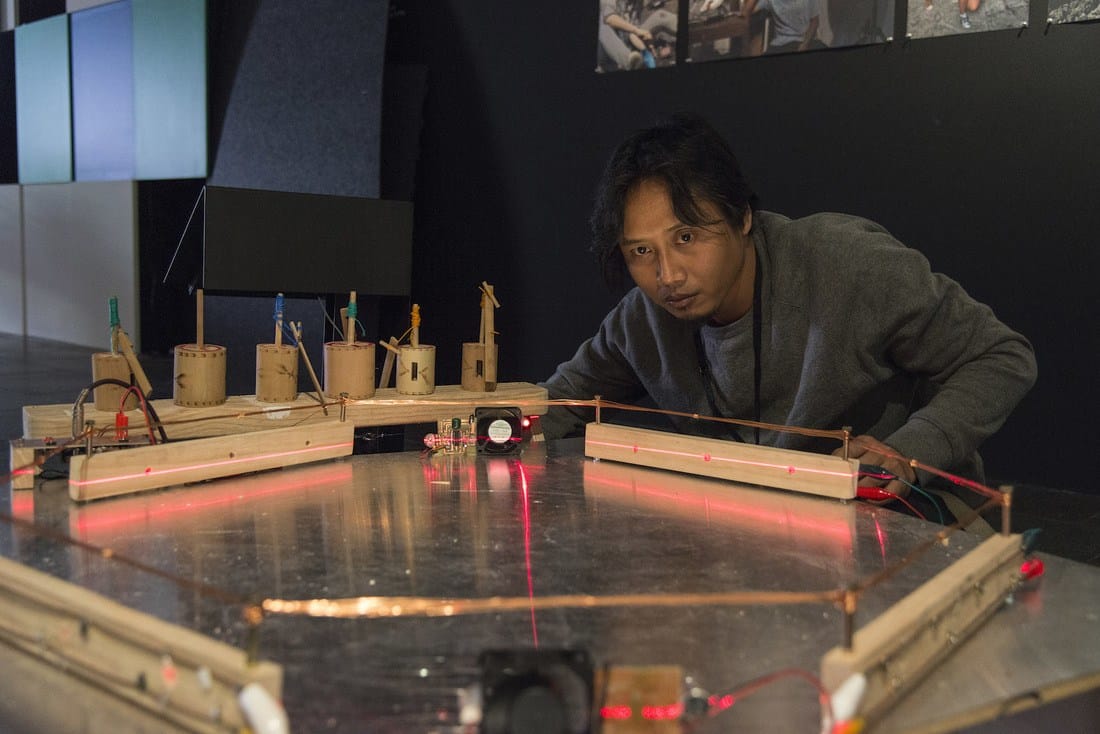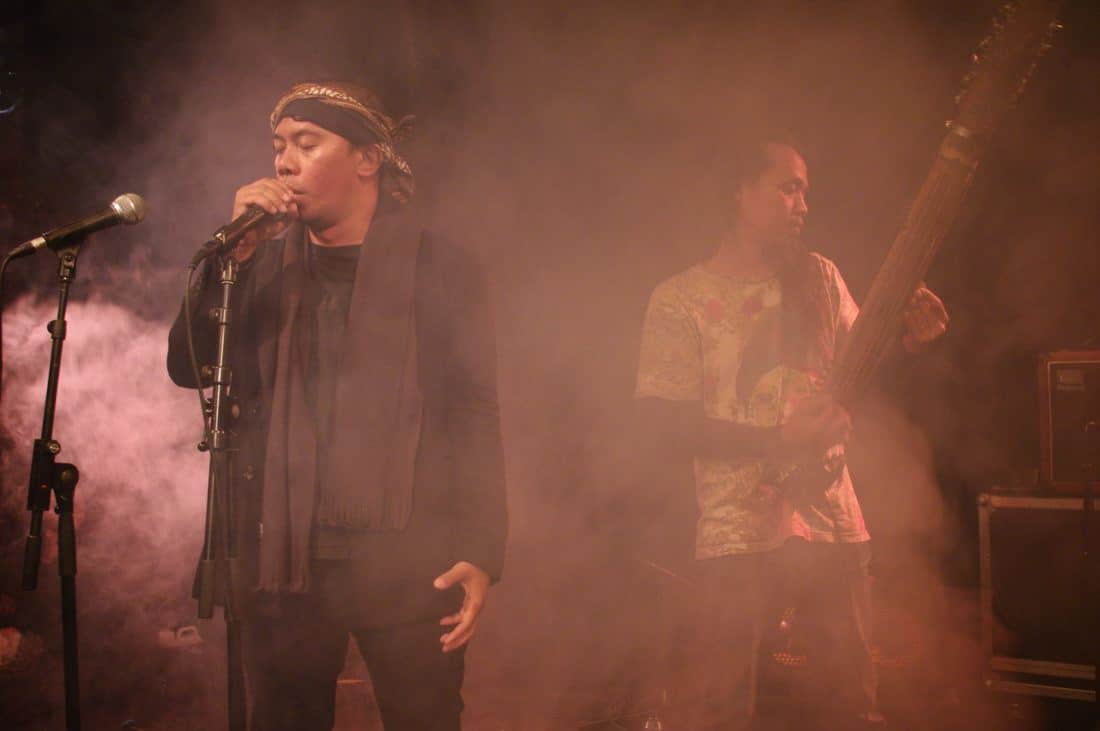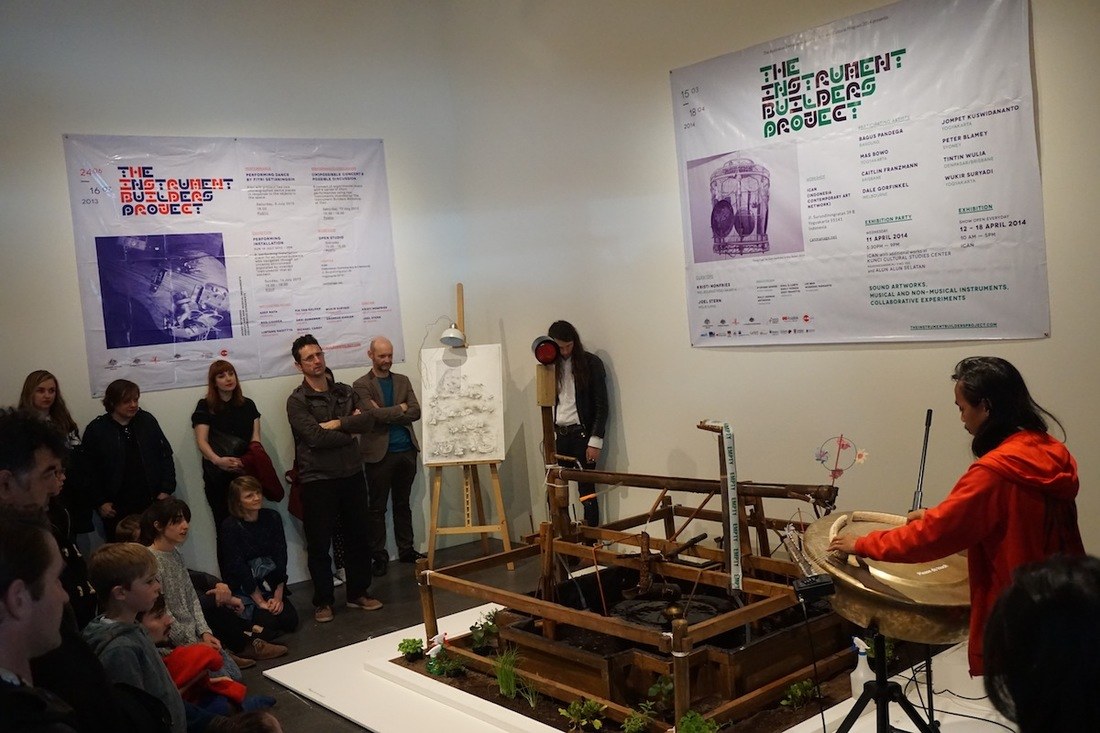
Spinning Fields, by Lintang Radittya (pictured), Michael Candy and Andreas Siagian, drew on the children’s game gangsingan. Photo by Kristi Monfries.
An air-powered organ incorporating cages sourced from the Yogyakarta bird market, a pedal-powered angklung, and a synthesiser operated by the wind, moisture and soil conditions on Mount Merapi. These are just a few outcomes of the open-ended experimentation and cross-cultural collaboration that defined the Instrument Builders Project (IBP).
The Instrument Builders Project ran from 2010-2014 and brought together Australian and Indonesian artists from a diversity of practices and backgrounds. The project comprised two iterations in Yogyakarta at the Indonesian Contemporary Art Network (iCAN) in June 2013 and March 2014, and a third iteration at the National Gallery of Victoria, Melbourne, in November 2014.
The next iteration of the project will see the launch of the Instrument Builders Project book, Hits From the Gong. The publication charts the creative process of all three iterations, through extensive imagery and essays by writers including Helen Hughes (research curator, Monash University Museum of Art), Clinton Green (independent music writer), Antariksa (senior researcher, KUNCI Cultural Studies Centre, Yogyakarta), Serena Bentley (assistant curator, National Gallery of Victoria) and Wok the Rock (director, Ruang Mes56).
Senyawa, a music duo from Java, consisting of Rully Herman and Wukir Suryadi, will be headlining the launch. They have been intricately involved with the IBP since its inception, with Wukir Suryadi the only artist to participate in all three iterations. Wukir’s work as a musician and instrument builder seamlessly blends his traditional Indonesian upbringing with contemporary music practices. This merging of traditional and contemporary was the conceptual starting point for this long-term cross-cultural collaborative project.
Senyawa has a close relationship with the Australian arts community. Their first big break was at the International Melbourne Jazz Festival in 2011. They have since been assisted by a solid network of Australian musicians and artistic allies and through this network were catapulted onto the international stage. They have gone on to perform extensively throughout Europe, Japan and Asia and are scheduled to tour the United States in August.

Senyawa have built a strong relationship with the Melbourne artistic community. Photo by Kristi Monfries.
As project curators, Joel Stern and I worked with 16 lead artists, along with supporting artists and production teams in Indonesia and Australia. The IBP hosted many presentations and public events, producing at least 25 new works, performances, instruments and installations over the three iterations. Artists generally worked collectively on multiple instruments.
The range of ideas and approaches that produced these works were as diverse as the artists themselves. Mixing traditional craftsmanship with mechanic assemblage were instruments such as Wukir’s Acar Mahoni, a multi-player guitar synth theramin, and Table Top Hurdy Gurdy. These contrasted with socially engaged and relational projects like Tintin Wulia’s Odong Dangding Prototype, the pedicab-powered angklung, and Caitlin Franzmann’s aural head-gear navigation system, Between Two Ears, Between Two Trees. A number of works instrumentalised hacker forms of technology to explore the mythologies of nature, such as the two collaborations by Pia Van Gelder, Michael Candy and Andreas Siagian, Mount Operated Synthesiser and Noble Wave, which harnessed nature’s energy to power synthesisers, and Peter Blamey’s Motherboard Tree, which used solar rays to create sounds.

Wukir Suryadi’s Ekologi Gong. Photo by Kristi Monfries.
The highly open structure of the project meant that it was difficult, and indeed not productive, to try to pre-determine outcomes. Each iteration of the IBP was free to fail or succeed, with the emphasis on the artistic process and facilitating an environment for experimentation. From its initial concept, the project splintered into many creative directions, so that the ownership of works and ideas felt collective to everyone involved, from the artists, to the production team, to the technical assistants who worked to help realise the artists’ ideas.
Documenting the process through the various mediums available became a work in itself. The comprehensive website, Instagram tags, Vimeo, Twitter hashtags, Facebook, and the many articles that charted the three-year progress all helped to build the IBP community.
The IBP was defined by its geographical and geopolitical context. It was first conceived around the time that the Asian Century White Paper was published and informed policy-making, especially cultural policy. While the IBP was able to ride on this wave of policy support, what actually consolidated the engagement were the many Australian artists who had for years engaged artistically with Indonesia through independent initiatives, self-funded residencies and research. As the IBP expanded, the geographical context became less important. Initially, however, it was useful to conceptualise and create new forms of work— sounds, instruments, performances, experiments — outside the usual artistic centres, in a place where different cultural traditions, practices and values could collide and entangle.
Over the past decade, since Claire Bishop published her controversial essay, “The Social Turn”, the concept of collaboration in the arts has been highly topical. This article and her seminal book, Artificial Hells, galvanised collaborative artistic practices in the west. Yet collaborative work is how many Indonesian artists collectives have survived and function. It is what makes Indonesia, and Yogyakarta in particular, of artistic interest to many visiting international curators and arts workers. As Andreas Siagian, of citizen science collective LifePatch, says, in Indonesia it’s not DIY, its DIWO – do it with others. This inclusiveness was the IBP’s overall ethos and ultimately its model for successful collaboration.
The Instrument Builders Project book, Hits From the Gong, will be launched at 8pm on Thursday 19 May at The Tote in Collingwood, Melbourne. IBP artists Pia Van Gelder, Peter Blamey, Dylan Martorell and Dale Gorfinkel will be performing alongside internationally acclaimed Indonesian music experimentalists Senyawa. Tickets are available at the door $15 or $40 with the book (limited edition print of 400 copies).
The IBP book launch is presented in collaboration with Asialink Arts.




